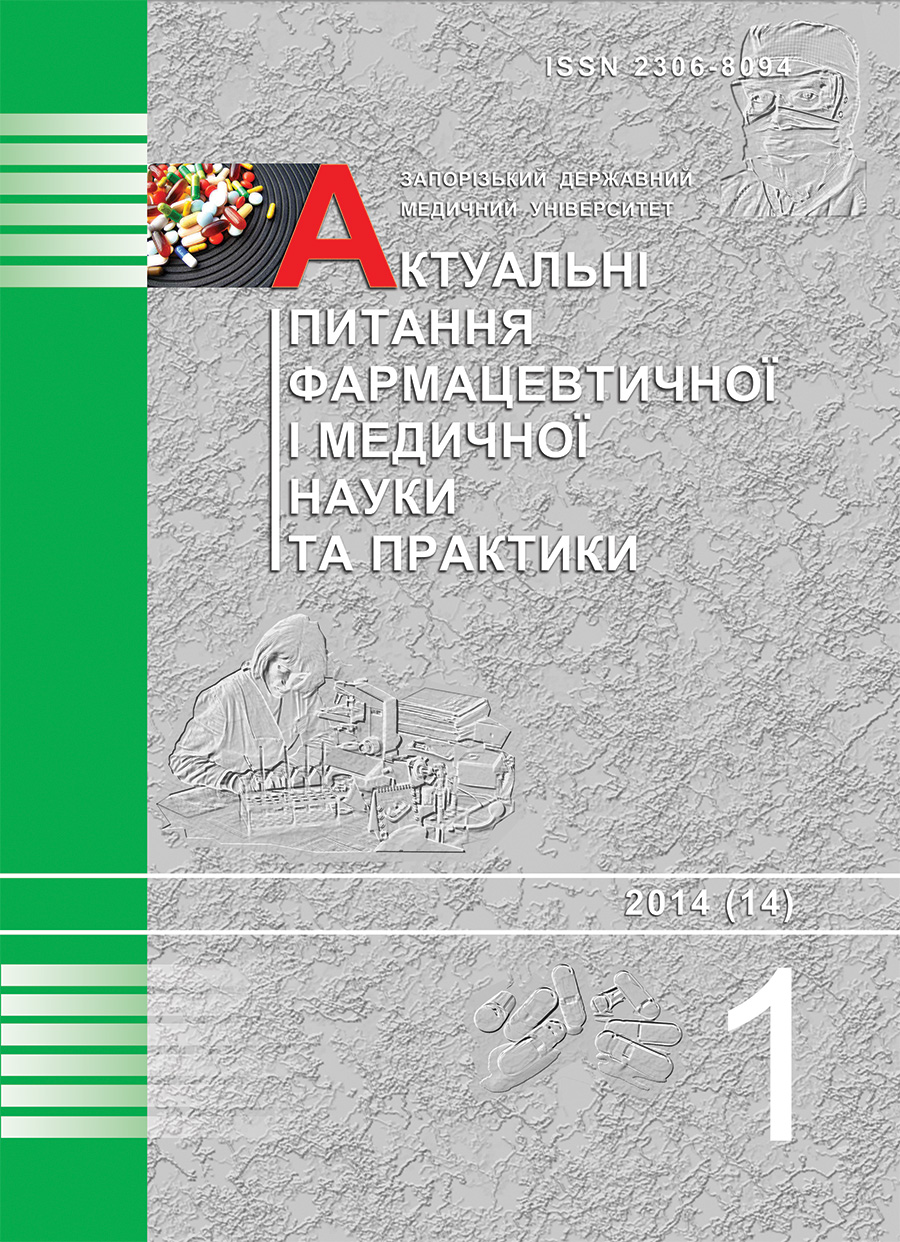The study about hepatoprotective activity of chicory extract (Cichorium intybus L.)
DOI:
https://doi.org/10.14739/2409-2932.2014.1.24527Keywords:
hepatoprotective effect, chicory extracts, tetrachloromethane, alanine aminotransferase, aspartate aminotransferaseAbstract
Introduction. Nowadays hepatobiliary disorders are widespread throughout the world and affect more than 2 billion people. They often lead to serious complications and death, and thus significant economic losses [4].
Therefore, the search and development of new effective drugs for the treatment of this pathology is an important task of pharmacy and pharmacology. Recently drugs that protect liver cells, namely hepatoprotectors, become increasingly popular. Hepatoprotectors’ action is aimed at restoring homeostasis in the liver, normalizing its functional activity and stimulation of regeneration processes.
There is a lack of drugs obtained from plants which are produced in Ukraineand could be used in the treatment of liver diseases. This necessitates the search of new low-toxic and effective herbal drugs. The perspective plant from this point of view is chicory (Cichorium intybus L.), which is characterized by a high content of biologically active substances [2,7].
The aim of research was to investigate the hepatoprotective activity of the chicory extract and its effects on morphology and functional activity of the liver by using the rat model of chronic tetrachlormethane-induced hepatic injury.
Materials and methods. The object of the study was an extract of chicory roots obtained by using 50% ethanol and made by repercolation method. Content of hydroxycinnamic acids calculated as chlorogenic acid was 0,0242 ± 0,0005%. Experimental studies were performed on 18 adult albino male rats weighing 180 ±20 g.
Animals were randomly divided into 6 groups each consisted of 6 rats. The first group is intact animals. The second group of animals was administered daily intragastrically 50% ethanol (0,15 ml / kg) throughout the experimental period. In the third, fourth, fifth and sixth groups of animals chronic liver injury was induced by repeated intragastric administration of 20% CCl4 solution in olive oil (2 ml/kg b.wt.) two times a week for 30 days. Besides this fourth group of animals received daily intragastrically 50% ethanol (0,15 ml / kg), the fifth group - chicory extract daily intragastrically (150 mg / kg b.wt.), sixth group - silibor daily intragastrically (150 mg / kg b.wt).
Results. In the group of rats receiving CCl4 and chicory extract liver morphology and serum enzymatic activity had a tendency to improve. In particular, ALT increased only 2,3 times (p < 0,0002) compared with the second group, AST – 1,6 times (p < 0,0008). These levels of enzyme activity were lower than in the fourth group of animals: ALT – 2,3 times (p < 0,004), AST – 1,3 times (p <0,027), AP - в 1,3 times (р<0,028). Morphologic signs of tissue injury in the fifth group were less prominent than in the fourth group. The described changes indicate hepatoprotective effect of the drug.
Conclusions. The results showed that the investigated chicory extract has hepatoprotective effect in rats with chronic CCl4 – induced liver injury, manifested by decreased serum AST, ALT, AP activity and lower degree of liver damage. According to its hepatoprotective activity the extract of chicory was not inferior to silibor.
Thus, the water-alcohol extract of chicory is a promising agent for further study to develop a drug with hepatoprotective properties.
References
Бакулин И.Г. Возможности применения гепатопротекторов в практике врача-терапевта / И.Г. Бакулин, Ю.Г. Сандлер // Consilium medicum. Гастроэнтерология. – 2010. – № 8. – С. 72–76.
Барабой В.А. Биологическое действие растительных фенольных соединений / В.А. Барабой. – К. : Наук. думка, 1976. – 260 с.
Крылова С.Г. Гепатозащитное действие экстракта из корня Cichorium intybus (Asteraceae) / С.Г. Крылова, Л.А. Ефимова, З.К. Вымятнина, Е.П. Зуева // Растительные ресурсы. – 2007. – № 2. – С. 89–94.
Попович В.П. Тенденції ринку гепатопротекторів в Україні / В.П. Попович, Б.П. Громовик, П.В. Глуховський // Актуальні питання фармацевтичної та медичної науки та практики. – 2012. – № 1. – С. 95–99.
Румянцева Ж.Н. Поиск гепатопротекторов среди препаратов растительного происхождения / Ж.Н. Румянцева, Я.С. Гудивок // Раст. ресурсы. – 1993. – № 1. – С. 88–97.
Стефанов О.В. Доклінічні дослідження лікарських засобів : методичні рекомендації / [за ред. О.В. Стефанова]. – К. : Авіцена, 2001. – 568 с.
Яворський О.І. Біологічно активні речовини та фармакологічна активність коренів цикорію / О.І. Яворський, Б.М. Зузук, Л.Я. Роговська // Фармац. журн. – 1993. – № 1. – С. 70–75.
Яворський О.І. Ліки з цикорію – цінні та ефективні засоби в арсеналі практичного лікаря / О.І. Яворський // Практична медицина. – 1997. – № 1–2. – С. 48–53.
Papetti A. Anti- and pro-oxidant water soluble activity of Cichorium genus vegetables and effect of thermal treatment / A. Papetti, M. Daglia, G. Gazzani // J. Agric. Food. Chem. – 2002. – Vol. 50б. – № 16. – Р. 4696-4704.
Walsh K. Update on chronic viral hepatitis / Walsh K., Alexander G.J. // Postgrad Med. J. – 2001. – Vol. 77. – P. 498–505.
Downloads
How to Cite
Issue
Section
License
Authors who publish with this journal agree to the following terms:
Authors retain copyright and grant the journal right of first publication with the work simultaneously licensed under a Creative Commons Attribution License that allows others to share the work with an acknowledgement of the work's authorship and initial publication in this journal. 
Authors are able to enter into separate, additional contractual arrangements for the non-exclusive distribution of the journal's published version of the work (e.g., post it to an institutional repository or publish it in a book), with an acknowledgement of its initial publication in this journal.
Authors are permitted and encouraged to post their work online (e.g., in institutional repositories or on their website) prior to and during the submission process, as it can lead to productive exchanges, as well as earlier and greater citation of published work (See The Effect of Open Access)

